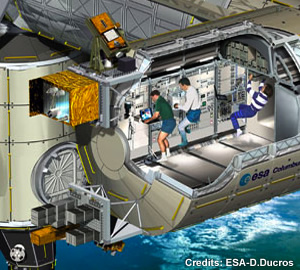| European Space Agency ESA |

|
ESA Internationale Raumstation ISS |
|

|
ESA Internationale Raumstation ISS |
|
|
Internationale Raumstation ISS
|
|
Columbus Laboratory
|
 |
 |
| Columbus
Laboratory |
 |
The
science module Columbus is ESA's biggest single contribution to the International
Space Station. The 4.5-metre cylindrical module will give an enormous boost
to the station's research capabilities. During its 10-year projected lifespan,
Earth-based researchers - sometimes with a little help from the ISS crew
- will be able to conduct thousands of experiments in life sciences, materials
science, fluid physics and a whole host of other disciplines, all in the
weightlessness of orbit.
To
keep costs low and reliability high, Columbus shares its basic structure
and life-support systems with the Italian Space Agency's Multi-Purpose
Logistics Modules (MPLM). |
|
But
whereas the MPLM is aptly described as a 'space moving van' - albeit a
very sophisticated moving van - the 75 cubic metres of space inside Columbus
contains an entire suite of science laboratories. The module has room for
10 International Standard Payload Racks, each hosting an entire laboratory
in miniature - complete with power and cooling systems, and video and data
links to researchers back on Earth.
ESA
is developing a range of payload racks, all tailored to squeeze the maximum
amount of research from the minimum of space and to offer European scientists
across a wide range of disciplines full access to a weightless environment
that cannot possibly be duplicated on Earth. The Biolab, for example, supports
experiments on micro-organisms, cell and tissue culture, and even small
plants and animals. Another rack contains the European Physiology Modules,
a set of experiments that will examine how the human body behaves in the
absence of gravity. With luck, the results of these could lead to improved
treatment for age-related bone loss and other ailments back on Earth. A
Material Science Laboratory will investigate solidification physics, notably
zero-gravity crystallization, and a Fluid Science Laboratory will accommodate
experiments in the strange behaviour of weightless liquids. These too,
could bring far-reaching benefits on Earth: better ways to clean up oil
spills, for example, and even improved manufacture of optical lenses.
Outside
its comfortable, pressurized hull, Columbus has four mounting points for
external payloads. Exposed to the vacuum of space, science packages can
investigate anything from the ability of bacteria to survive on an artificial
meteorite to volcanic activity 400 km below on the Earth.
Columbus
in orbit is only the most obvious and impressive part of the whole research
programme. Columbus on the ground will involve researchers all over Europe,
who will be able to control their own experiments directly from several
User Centres or even directly from their workplaces. Their efforts will
be channelled through the Columbus Control Centre in Germany, which will
interface with the module itself and also ESA's NASA partners in the United
States.
Like
the Genoese navigator for whom it was named, Columbus is set for a long
journey of exploration. But thanks to broadband telecommunications, hundreds
- perhaps thousands - of explorers will be able to work aboard during its
10-year mission.
The
actual launch date of Columbus is not known at present - it is dependent
on the success of the Return to Flight of the Space Shuttle.
| Source:
Text ESA 2005 |
 |
nach
oben
| Weiterführende
Informationen |
 |
| Links |
 |
 |
 |
Externe Links |
|

